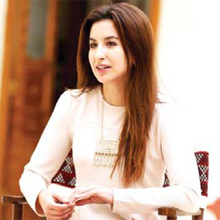 Sheikha Bibi Duaij Al-Sabah, Chairperson of Al-Sadu House Handcraft Society
Sheikha Bibi Duaij Al-Sabah, Chairperson of Al-Sadu House Handcraft SocietyAs Kuwait’s pace of modernization accelerates, it rapidly loses iconic buildings and artifacts of its cultural heritage, but at least one beautiful example of its architectural history is still standing tall. Sadu House is a unique tourist attraction of Kuwait, and a symbol of protecting and preserving Kuwait’s past. It strives to protect the interests of bedouins and their ethnic handicrafts. ‘Al Sadu’ is the term used by the bedouin to refer to the traditional weaving process.
Kuwait Times spoke with Sheikha Bibi Al- Sabah to learn more about Sadu House. Sheikha Bibi Duaij Al-Sabah, Chairperson of Al- Sadu House Handcraft Society grew up around Sadu House. Her mother, Sheikha Altaf Al- Sabah, was one of the founders of the Sadu project launched in 1978, and which moved into the house in 1980. Sheikha Bibi aims to get more Kuwaitis to experience the tradition professionally and not only as a passion, and promotes it to the younger generation to make them feel that they are a part of this beautiful culture.
Kuwait Times: Tell us about the history of Sadu House.
Sheikha Bibi: The house was built in 1936 in the Kuwaiti architectural style by Yousef Al- Marzouq. Al-Marzouq was a prominent merchant trading with India, especially in wood, who made the distinctive woodwork a focal point of the house. When the house was purchased by Shereen Behbehani in 1938, a second floor was added along with new tiles and European fireplaces. The house has four open courtyards and traditional long rectangular rooms throughout.
In the 1960s, the house was purchased by the state and was under the Ministry of Information, and later the National Council for Culture, Arts and Letters. In 1978, we reached an agreement to make the building the headquarters of Al Sadu project - which was under the auspices of the Ministry of Social Affairs - for the preservation of Bedouin weaving, and it was used as a showcase for the traditional weavings of Kuwait. The Al Sadu Weaving Cooperative Society was established in 1991 to boost the project.
KT: From which materials was it built and who built it?
Sheikha Bibi: This is one of the first houses to be built of concrete to reinforce the stone structure. The design was by an Indian, and it was built by Kuwaiti workmen and carpenters under the supervision of Kuwaiti builder Rashid Al-Benai.
There is a small museum in the house that explains the story of weaving. We also have a library for scholars that houses books about regional crafts as well as our commissioned studies on Sadu weaving. The gift shop displays traditional work by local artists inspired by traditional weavings. There are rugs/wall hangings, bags, wallets and home furnishing items for sale, and all the proceeds go to the local weavers and artisans.
KT: Are there any particularly interesting architectural features or design elements of the house?
Sheikha Bibi: The house shows strong Indian decorative influences exemplified in the wooden patterns and motifs on the doors, windows and wall cabinets. The house also has 17 badgirs (wind catchers). They are spread throughout the house to make sure it is wellventilated and cooled.
KT: What were some interesting events/activities that took place in the house?
Sheikha Bibi: Three years ago, we had an event that was dedicated to the house. We called it “The Story of the House” and invited a member of the Behbehani family. He shared his childhood stories and memories with us and told us that he was born in one of the rooms in the corner. It was an emotional homecoming event for the Behbehani family.
KT: What are the missions of Sadu House?
Sheikha Bibi: The Sadu Society is dedicated to preserving, documenting and promoting the rich and diverse textile heritage of Kuwaiti Bedouins, from the nomadic weaving of the desert to the urban weaving of the town. It is the first weaving craft cooperative in Kuwait. The shares are owned by the artisans, with profits going to supporting the artisans and their work.
KT: How does the house itself serve as a focal point of Kuwait heritage, tradition and culture?
Sheikha Bibi: Our project honors and celebrates the values of productivity and creativity as embodied in traditional textile arts. These important aspects of material culture reflect and reinforce a cultural identity for both present and future generations. The house as a traditional building reflects Kuwait’s social and cultural history as well. As the headquarters of the Sadu weaving story, it strives to create a holistic experience for visitors. As you go inside, you get to understand two narratives - of traditional architecture and weaving.
By Faten Omar










